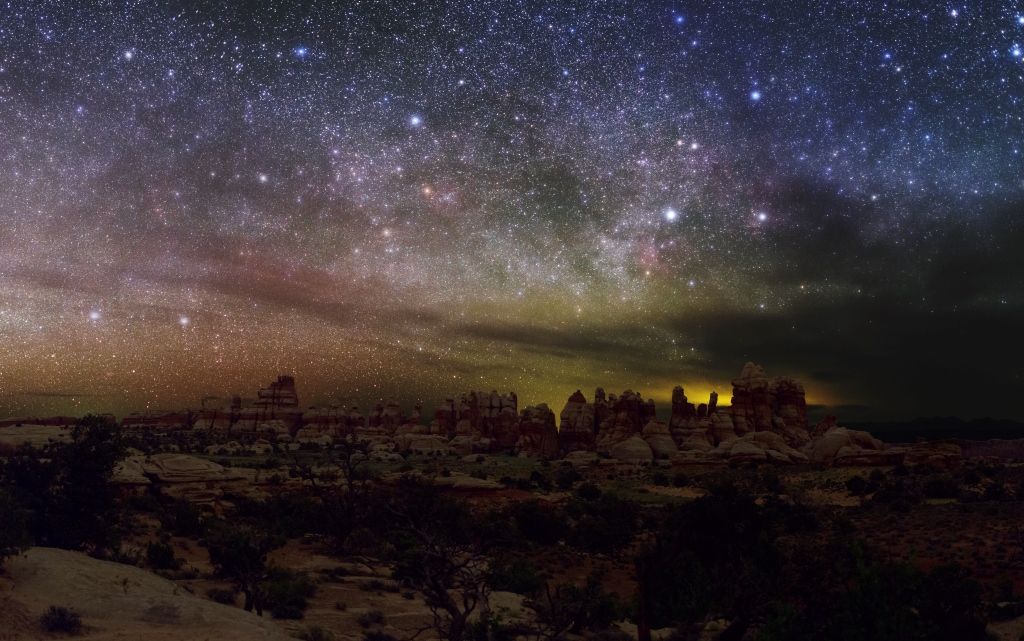Some information may be outdated.
The International Dark-Sky Association announced this week that it granted Canyonlands National Park its Gold-Tier International Dark Sky Park status – an honor reserved for the darkest of dark skies and the most stunning of starscapes.
“It is truly a pleasure to recognize efforts at Canyonlands to expand the reach of dark skies protections across the Colorado Plateau,” IDA Executive Director J. Scott Feierabend said. “The park’s achievement helps bring the awe-inspiring experience of an authentically dark, natural night to over half a million visitors a year.”
Canyonlands was designated a national park in 1964 and provides visitors opportunities to view spectacular scenery, explore rugged landscapes and experience remote wildness and solitude. The stunning scenery and expansive landscapes of Canyonlands don’t end when the sun sets.
“The Milky Way stretching across the park’s incredibly dark night sky is a sight many visitors will never forget,” Canyonlands Superintendent Kate Cannon said. “With this gold-tier designation, the International Dark-Sky Association recognizes the importance of the natural darkness found here.”
Efforts to preserve natural darkness in Canyonlands began several years ago with a focused effort to revamp and replace park lighting with “night-sky friendly” bulbs and fixtures. Nearly 100 percent of the park’s lights are now “night-sky friendly.” Natural darkness is also recognized in park management documents, which clearly state the value of night skies and the park’s commitment to protect them.
Visitors from all over the world attend night sky programs at the Island in the Sky and Needles districts of the park, where rangers use story-telling and telescopes to introduce the wonders of the universe to park visitors. Many of these visitors have never seen the Milky Way or a star-filled sky due to where they live. In many national parks, astronomy events are the most popular ranger-led programs, and “astrotourism” enhances economic benefits to nearby communities.
Canyonlands National Park is one of four national parks included in the National Park Service’s Southeast Utah Group. These parks include Hovenweep National Monument, awarded an International Dark Sky Park in 2014, and Natural Bridges National Monument, which was designated the world’s first International Dark Sky Park in 2007. Arches National Park is also included in the Southeast Utah Group. The four parks work together with neighboring businesses, communities and land managers to help conserve some of the darkest skies in the United States.
Canyonlands is also a member of the growing Colorado Plateau Dark Sky Cooperative. Established in 2012, America’s first Dark Sky Cooperative links communities, tribes, businesses, state agencies, federal agencies and citizens in a collaborative effort to celebrate the view of the cosmos, minimize the impact of outdoor lighting, and ultimately restore natural darkness to the area. The Dark Sky Cooperative encourages community-based, landscape-scale approaches to conservation to solve today’s land management challenges.
“This award for Canyonlands represents the National Park Service’s dedication to lead the way in preserving natural darkness as a precious resource on the Colorado Plateau,” Colorado Plateau Dark Sky Coordinator Nate Ament said.
Canyonlands joins other IDA Dark Sky Places already designated on the Colorado Plateau, including Flagstaff, Arizona; Capitol Reef National Park; Grand Canyon-Parashant National Monument in Arizona; and Chaco Culture National Historical Park in New Mexico.
As a newly designated International Dark Sky Park, agency officials say Canyonlands will remain committed to mitigating light pollution within park boundaries and showcasing the dark night skies to visitors. On Friday, Sept. 18, the National Park Service, in partnership with the Friends of Arches and Canyonlands Parks, will host a public ceremony and astronomy event at Island in the Sky to commemorate the park’s new designation.
Appreciate the coverage? Help keep local news alive.
Chip in to support the Moab Sun News.





